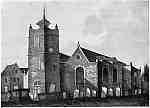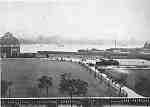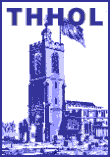In the Act of Parliament that authorised the recovery of one hundred and thirty acres of watery waste, afterwards known as Wapping Marsh, the eastern boundary of the area is described as abutting on the town of Ratcliff, which apparently was considered as reaching to Foxes Lane that was adjacent to Wapping Wall. At that time, 1587, Shadwell in name did not exist, and some hundred and forty years later (the parish having been formed in the meantime) a Lady Theodosia Ivie made a claim to seven and a half acres lying alongside the river in Lower Shadwell, alleging that they formed part of the land drained by Cornelius Vanderdelf, and that the property was hers by right of inheritance.
Lady Ivie, who was described as "so many years famous for her Wit, Beauty and Cunning in Law above all any," sometime lived in Wapping. She was the grand-daughter of John Stepkin, in whom Richard Hill's share in the marsh had become vested. She thrice married; her second husband being Sir Thomas Ivie, who had gained wealth in trade with the East Indies, and with whom she lived unhappily. Her contention was that the eastern boundary of Wapping Marsh was Ratcliff, at Cock-Hill, anciently called Hilly-way or Mill-bank, and in the records of Stepney Manor called Cornhill; that the hundred and thirty acres could not be made up without the inclusion of those that were claimed and that were referred to in a lease purported to have been made in 1555, and in another deed dated three years later. In the first instance judgment was given in her favour, but upon further proceedings taking place in 1684 before Chief Justice Jeffreys the verdict was given against her, and as the deeds on which she relied were found to be forgeries he directed them to be impounded and that Lady Ivie should be prosecuted. The lady was tried in 1686 and acquitted, probably owing to insufficient evidence to justify a conviction. She persisted in maintaining until her death that the property belonged to her. Excepting those references to the locality, the details of the case, the conduct of it and the behaviour of the Chief Justice, interesting as they are, must be passed aside as being unnecessary to the present purpose of giving an outline of the development of Shadwell.
As late as 1615 the riverside between what is now Wapping and Ratcliff was unbuilt upon except to the northward, where there were several houses, including at least one of fair size which had a brewhouse and a large orchard. This land, on which Lower Shadwell stood, and which is now for the most part occupied by the King Edward VII Memorial Park, was included in the property, which extended to Ratcliff Highway, of the Dean and Chapter of St. Paul's, whose title to it went back more than three centuries. How they came to hold the land independently of the manor of Stepney, even in the days when it belonged to the Bishop of London, is a matter of conjecture, but from the fact that in ancient times the maintenance of the river walls and ditches on the marshes east of St. Katharine's was confided to their care, it is likely that the reclamation of the land from the river in this particular locality was their work, and the possession of it their reward. In support of this supposition it may be remarked that there was once along Ratcliff Highway a strip of ground known as the Dean's Lynches, the description implying the greensward on the border of the marsh. In the beginning of the seventeenth century the seven and a half acres of marshland in dispute were not of much value. They were irrigated by a number of cuts or channels, the principal one leading westward from the Thames at Bell Wharf by Cock-Hill, through which the water of the incoming tide swum up into the ponds and ditches, which received and retained it for a while so that it might return at a uniform rate of flow to work the wheel of Ratcliff mill.
The increase in the value of the riverside land and the building upon it was the result of the rise of the shipping industry, which, having begun at Deptford, Blackwall and Ratcliff, in due course made Lower Shadwell a place of some importance and prosperity. In 1615 there were but ten ships of more than 200 tons belonging to the Port of London, while in 1640 there were a hundred ships of sail capable of being converted into men-of-war, besides which a hundred ships had been added to the navy. In a few years houses and streets came into existence and were occupied by boat-builders, sail-makers, mast-makers, riggers, biscuit-bakers, coopers, ships' chandlers, anchor-smiths, besides others engaged in marine occupations.
The neighbourhood was developed under the direction of Thomas Neale, the lessee of the Dean and Chapter of St. Paul's. This remarkable man died insolvent about 1699 after a varied career, during which he ran through two fortunes, doubtless through gaming and speculative tendencies. He was Master of the Mint from 1678 to the date of his death, when he was succeeded by Sir Isaac Newton, who found the establishment a nest of idlers and jobbers. About 1684 Neale was appointed groom-porter to Charles II. His duties in that capacity were to see the King's lodgings furnished with tables, chairs and firing, to provide cards and dice, and to decide disputes at the card-table and on the bowling-green. He was authorised by the King to license and suppress gaming-houses, and to prosecute unlicensed keepers of "rafflings" and other public games. On his own account he originated a loan and lottery business "on the Venetian system," that was not without some measure of success. As a projector and speculator he promoted building schemes, among which were the converging streets of Seven Dials - one of them Neal Street, Long Acre, still bears his name - and Lower Shadwell.
Indeed, the first building venture undertaken by Neale was at the latter place, where in 1656 - in Commonwealth times - he had already commenced operations which he afterwards carried out in a thoroughly business-like manner. He was interested in East India trade, and he and his friends doubtless perceived that the development of the river frontage would bring profit and advantage with the increase of shipping. The property of the Dean and Chapter had been in 1649 exposed for sale as church lands, and as such sold for £9,500, and were enjoyed by the purchasers till the Restoration, when Neale, whatever may have been his position previously, appears on the scene as the lessee.
Through Court influence and on petition of the inhabitants, Charles II granted a charter to the hamlet of Shadwell to hold a fair and market. Shortly afterwards, in 1669, by Act of Parliament, the parish was created out of Stepney, having an area of small extent; its greatest length being roughly 900 yards, and with a breadth of about 750 yards. It was divided into Upper and Lower Shadwell, the former being principally occupied by Sun Tavern Fields. In the same year Neale, having drained in Lower Shadwell some of the watercourses previously mentioned as having, at an earlier period, worked the mill, conceived the idea of utilising the site of the large ponds as waterworks, and he induced investors to take shares in the undertaking. It was a success the proprietors were made a body corporate in 1691, and business was carried on until 1800, when the concern was purchased for £50,000 by the London Dock Company.
 The
church shown in the illustration was demolished in 1817 and the present edifice was erected.
Built by Neale in 1656, first as a chapel, the old structure with the addition of a tower sixty
feet in height, became fifteen years later the parish church of St. Paul, a dedication in keeping
with the ground landlords, the Dean and Chapter, who are the patrons of the living.
The
church shown in the illustration was demolished in 1817 and the present edifice was erected.
Built by Neale in 1656, first as a chapel, the old structure with the addition of a tower sixty
feet in height, became fifteen years later the parish church of St. Paul, a dedication in keeping
with the ground landlords, the Dean and Chapter, who are the patrons of the living.
It is generally supposed that Shadwell owes its name to a spring dedicated to St. Chad or Cead, the famous bishop of the East Saxons and the second bishop of London, but this derivation is not consistent with the earliest known forms of the name which in the thirteenth century are found as Scadflet and Shatfliet. The Anglo-Saxon words "fleot," meaning a shallow creek or bay, may here appear as it does in "Northfleet," and "scead," a shade in the sense of shelter or shed. The spring which is supposed to have been dedicated to St. Chad, supplied a well eastward of the former church, and it has been stated that it is now beneath a pillar near the south-east corner of the church within the church yard. This spring is not to be confused with the mineral spring that was discovered in 1745 when sinking a well in Sun Tavern Fields. It is said that it was impregnated with sulphur, vitriol and antimony, and would, according to a pamphlet written by Dr. Linden, 1749, cure every disease.
In 1910, the Government considering how the life and reign of King Edward VII should be commemorated, were disposed to think that the object could be best secured by local, rather than national, memorials. It was felt that London should be foremost in doing honour to the memory of the late sovereign, and the Lord Mayor at once appointed a large and influential committee representing all sections of the community to report upon the question. A fund was opened, to which a considerable number of subscriptions were received from all classes. One of the suggestions, which was ultimately adopted, was that of a park at Shadwell.
In its construction many old and dilapidated houses and buildings were swept away, including the derelict fish market which had been established under powers conferred on a private company in 1882 and transferred with adjacent property - the site being about seven and a half acres - to the City Corporation in 1901, and which was valued in their books at about £140,000. The Corporation agreed to accept £70,000 for their interest in the property, thus benefiting the funds at the disposal of the Memorial Committee to that amount.
Owing to the war [i.e. the First World War] the laying out of the land was postponed, and the Memorial Committee found themselves unable to complete the work. The London County Council, realising that if they did not step into the breach the park might not be provided, decided to proceed with the work. They enlarged the site and were able, by negotiation, to remove certain disadvantages which would affect the amenities of the park.
In the Park, rising from a granite base the front of which forms a garden seat, a Portland stone shaft bears a bronze medallion portrait of the late King Edward with this inscription:-
IN
GRATEFUL MEMORY OF
KING EDWARD THE SEVENTH
THIS PARK IS DEDICATED
TO
THE USE AND ENJOYMENT OF THE
PEOPLE OF EAST LONDON FOR EVER.
OPENED BY
KING GEORGE
THE FIFTH
1922
 Until
the construction of the Park there was from the Tower [of London] to the Isle of Dogs
no access to the river; no vantage place to awaken imagination and to urge the spirit of adventure
by a view of the panorama of the Thames with the passing shipping. The illustration will give
some idea of the value of the Park, which, to be fully realised, should be visited on a summer's
day during school holidays, when it is crowded with children, some big, some small, and not
a few tiny tots, playing, quarrelling, shouting in high spirits as their fathers did before
them. Then should one turn to a stone boulder erected there and read the inscription incised
thereon - at the suggestion of the late Mr. Charles McNaught who loved East London - to the
memory of the brave adventurous men of other days, who, it must not be forgotten, once were
children too. It reads:-
Until
the construction of the Park there was from the Tower [of London] to the Isle of Dogs
no access to the river; no vantage place to awaken imagination and to urge the spirit of adventure
by a view of the panorama of the Thames with the passing shipping. The illustration will give
some idea of the value of the Park, which, to be fully realised, should be visited on a summer's
day during school holidays, when it is crowded with children, some big, some small, and not
a few tiny tots, playing, quarrelling, shouting in high spirits as their fathers did before
them. Then should one turn to a stone boulder erected there and read the inscription incised
thereon - at the suggestion of the late Mr. Charles McNaught who loved East London - to the
memory of the brave adventurous men of other days, who, it must not be forgotten, once were
children too. It reads:-
THIS TABLET IS IN MEMORY OF
SIR HUGH WILLOUGHBY, STEPHEN BOROUGH
WILLIAM
BOROUGH, SIR MARTIN FROBISHER
AND OTHER NAVIGATORS WHO IN THE LATTER
HALF OF TIlE SIXTEENTH
CENTURY, SET SAIL
FROM THIS REACH OF THE RIVER THAMES NEAR
RATCLIFF CROSS
TO EXPLORE
THE NORTHERN SEAS.
by Sydney Maddocks
